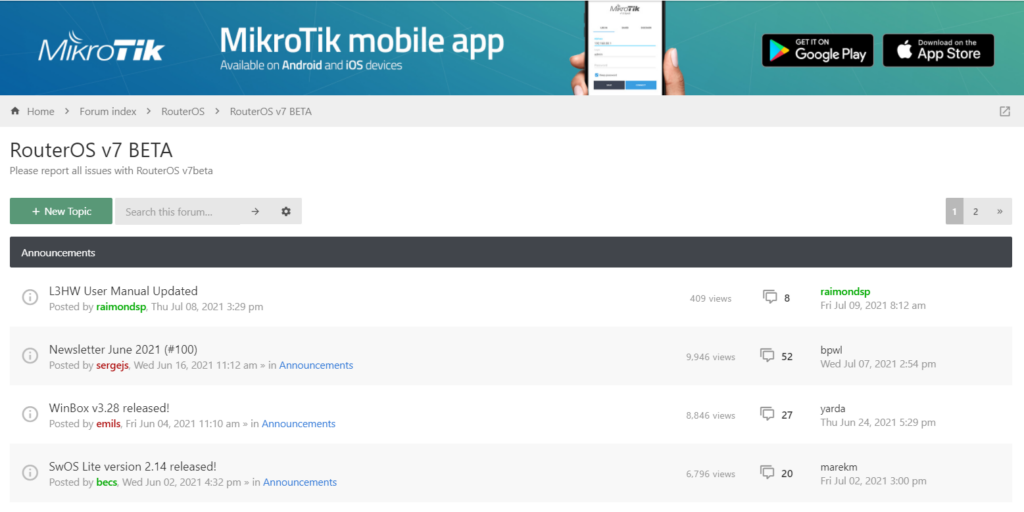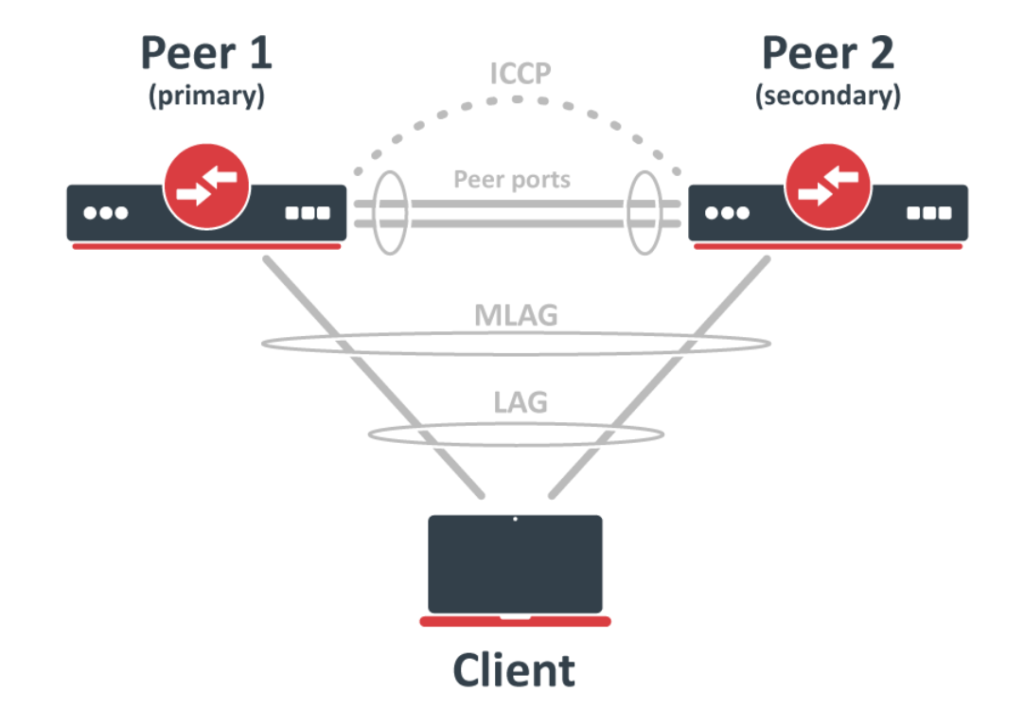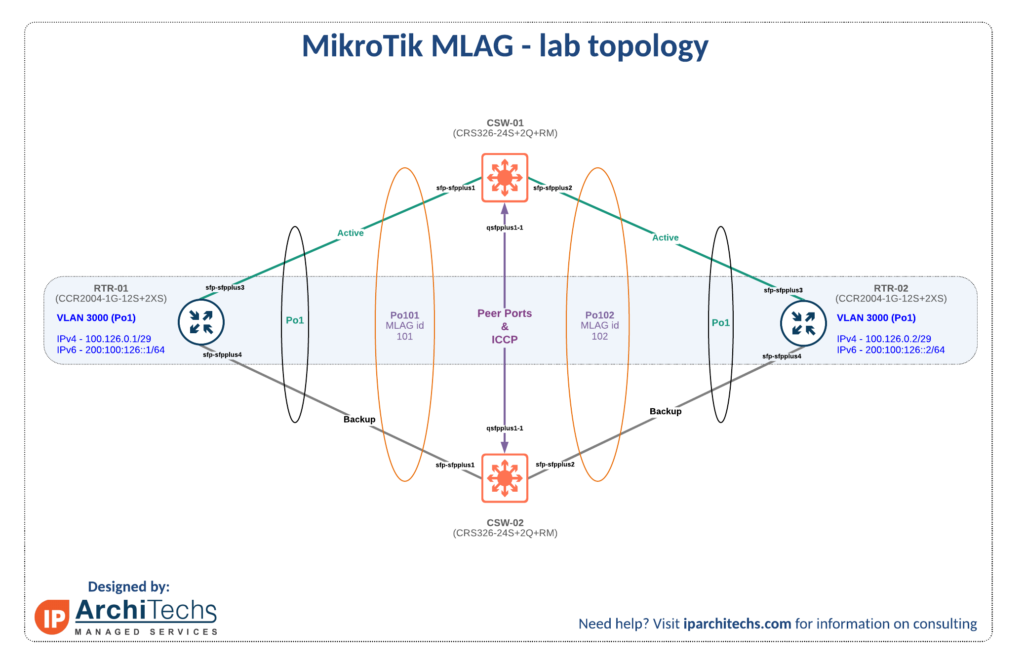
If you don’t already use it, the MIkroTik v7 BETA forum (forum.mikrotik.com) is a fantastic source of information
When will stable be released?
This is the million dollar question. Technically, it already has been for one hardware platform…
!! Spoiler Alert – There is *already* a stable release of ROSv7 – v7.0.3!!
The Chateau 5G router originally shipped with a beta version of ROSv7 but was quietly moved to a stable version that’s developed specifically for that platform.


Because of the way MikroTik’s code repo works, this version can’t easily be added to the main download page and support provides the software:
ROSv7.0.3 Stable Download (!!! Chateau Only – will brick other hardware !!!)
https://box.mikrotik.com/f/7e3cad5779804d0b878d/?dl=1
It’s worth repeating MikroTik’s warning about using this on any platform other than the Chateau


What’s holding up v7 from being released?
If you’ve been around MikroTik for a while, then you know that version 7 has been in the works for a long time to add new functionality and address limitations of the older Linux kernel in ROSv6.
MikroTik recently added a detailed update on where the development roadmap is at and what the challenges are:

What does this mean?
- Routing filters need to be rewritten to simplify the syntax and operation – there were a lot of complaints with the original syntax.
- Routing protocols like OSPF and BGP have been unstable in beta1 through beta6 and need some work to stabilize them.
What’s the issue with routing filters?
The original v7 routing filters were very complicated to work with and had esoteric terms for operations like ‘subsumes’ and required ‘rule’ and ‘select-rule’ config to actually reference the filter in the routing process.
Previous filter syntax:

I wrote an article in late 2020 on IPv6 with BGP/OSPF using beta2 and captured a few screenshots that aren’t in the online docs anymore.
More details are in the article here:
MikroTik – RouterOSv7 first look – Dynamic routing with IPv6 and OSPFv3/BGP – StubArea51.net
New syntax?
If the current filter documentation represents the newer style, there are several differences in the format. The more complicated language like ‘subsumes’ is gone and only one filter rule is required to use the filter in the routing process – the ‘select-rule’ syntax is gone.

The new filter syntax appears to have made it onto help.mikrotik.com under /routing/filter but this may change in the coming weeks.
Example:
Similar to the OSPF example above, this is the example listed under the filter section for the new format.

The options below represent the matching order and the possible readable and set parameters.
Accepted Syntax:
if ( [matchers] ) { [actions] } else { [actions] }
[matchers]:
[prop readable] [bool operator] [prop readable]
[actions]:
[action] [prop writeable] [value]
Accepted parameters:
[num prop readable]
dst-len
bgp-path-len
bgp-input-local-as
bgp-input-remote-as
bgp-output-local-as
bgp-output-remote-as
ospf-metric
ospf-tag
rip-metric
rip-tag
[num prop writable]
distance
scope
scope-target
bgp-weigth
bgp-med
bgp-out-med
bgp-local-pref
bgp-igp-metric
bgp-path-peer-prepend
bgp-path-prepend
ospf-ext-metric
ospf-ext-tag
rip-ext-metric
rip-ext-tag
[flag prop readable]
active
bgp-attomic-aggregate
bgp-communities-empty
bgp-communities-ext-empty
bgp-communities-large-empty
bgp-network
ospf-dn
[flag prop writable]
ospf-ext-dn
blackhole
use-te-nexthop
[predicate]
bgp-communities|bgp-communities-ext|bgp-communities-large
equal|any|includes|subset
{inline set}
equal-set|any-set|includes-set|subset-set
{set name}
any-regexp|subset-regexp
{regexp}
comment
text|find|regexp
{string}
chain
{chain name}
vrf
{vrf}
rtab
{rtab}
gw-interface
{interface}
gw-check
none|arp|icmp|bfd|bfd-mh
afi
ipv4|ipv6|l2vpn|l2vpn-cisco|vpnv4|vpnv6
,...
protocol
connected|static|bgp|ospf|rip|dhcp|fantasy|modem|vpn
,...
bpg-origin
igp|egp|incomplete
,...
bgp-as-path
{regexp}
rpki
valid|invalid|unknown
ospf-type
intra|inter|ext1|ext2|nssa1|nssa2
ospf-ext-type
type1|type2
[num prop readable]
in
{int..int}|{int-int}
==|!=|<=|>=|<|>
{int}
[prfx prop readable]
!=|==|in
{address 46/}
[flag prop readable]
[block]
if ([predicate] &&/|| ...) { [block] } [ else {[block]} ]
accept|reject|return
jump {chain name}
unset
pref-src|bgp-med|bgp-out-med|bgp-local-pref
bgp-communities|bgp-communities-ext|bgp-communities-large
append|replace|filter-in|filter-not-in
{inline community set}
append-set|replace-set|filter-in-set|filter-not-in-set
{set name}
filter-in-regexp|filter-not-in-regexp
{regexp}
delete
wk|other <-- for communities
,...
rt|soo|other <-- for ext-communities
,...
all <-- for large-communities
rpki-verify
{rpki group name}
comment
set|append
{string}
set
[num prop writable]
[num prop readable]|[num prop writable]
+/-
[num prop readable]|[num prop writable]
gw
interface
{interface}
{address 46i}
gw-check
none|arp|icmp|bfd|bfd-mh
pref-src
{address 46}
bgp-origin
igp|egp|incomplete
ospf-ext-fwd
{address 46}
ospf-ext-type
type1|type2
[num prop readable]
in
{int..int}|{int-int}
==|!=|<=|>=|<|>
{int}
[num prop readable]What are the problems with routing protocols?
The routing stack has been completely re-written for ROSv7 from what we are told. This takes some time.
When I was last out in Silicon Valley, I met with a company that just emerged from stealth and had designed a new Network OS. They spent 3 years in stealth working on nothing but the OS with no actual product being sold – just coding and development.
So it’s not surprising this process has taken a while.
Stabilizing protocol issues
There are a number of bugs we’ve seen in the early versions of ROSv7 beta for routing protocols that are being worked through. Things like OSPF checksum, interface templates, high cpu when areas are disabled/enabled….etc.
Now that we know routing protocols are a priority and the new filter syntax is taking shape, I would expect to see some improvement across the next 2 to 3 beta releases to get routing protocols stable with simple configs.
L3 Switching
From talking to a lot of people that write code for Network OSes and work on the interaction with the ASIC, this is one of the hardest areas to get right – pushing routes from the RIB down into the HW FIB.
MikroTik hired new developers to meet this challenge:

MikroTik has updated the L3 HW doc pages to provide a roadmap of features and functionality for the beta series.
It appears that Jumbo MTU is the next major feature to be added for L3 HW in ROSv7.1beta7

When will ROSv7 move to release candidate and then stable?
When asked about the state of ROSv7, my typical answer has been that we’ll see a stable version in mid 2022 based on the pace of development.
I think that’s still a fair answer based on the pace of development.
It seems like the routing protocols and filters we need a few more beta versions to get working and then they’ll move to release candidates – my estimate is to look for the RCs towards the end of 2021.
Hopefully this has been helpful…i’ll probably write another summary on the state of ROSv7 once more progress has been made.



